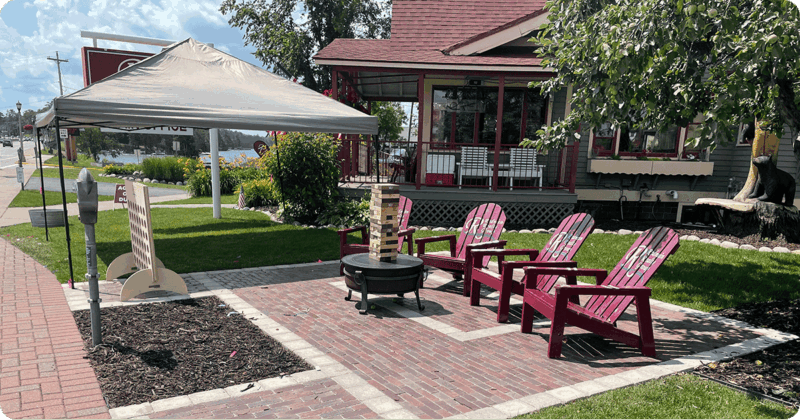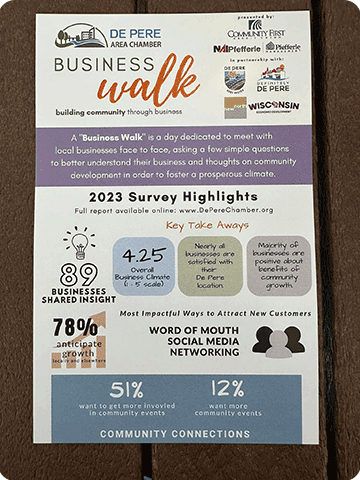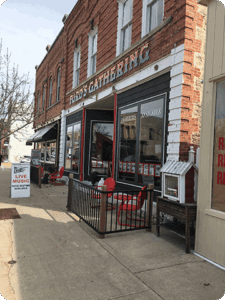
The economic vibrancy of a downtown is largely driven by the type and success of businesses in the district. A district with a wide variety of thriving businesses is inherently more economically productive and resilient than one with limited businesses targeting only certain demographics or with limited business hours. Additionally, the presence of successful businesses tends to foster other successful businesses, as entrepreneurs see the district as a desirable business address and increased foot traffic provides a built-in customer base for new establishments. While some districts are fortunate enough to have established businesses or anchors that drive sufficient traffic to support additional businesses, nearly all small business communities can benefit from a more intentional approach to retention and recruitment. The following article provides an outline for cultivating a supportive small business environment in your community.
Understand and support your existing businesses
Districts will not be successful in recruiting new businesses unless existing businesses are happy and thriving. Consider that:
- 80% of business growth is organic, whether from the expansion of existing businesses or spinoffs of businesses started by employees.
- Prospective business owners will want to talk to their future neighbors, and if the report is negative, they will probably look elsewhere for a new home.
- Understanding existing business markets and unmet needs will help craft an effective marketing and business assistance program that benefits all district businesses, whether new or preexisting.

De Pere recruits volunteers annually to conduct a business walk.
If a concerted effort has not been made to establish a business support network, a district should first start by conducting a business retention survey. This can be accomplished relatively informally with a “business walk” consisting of a coordinated series of visits to area businesses, typically including downtown board members, elected officials, municipal staff, and local partners. The goals of this walk should be to make personal connections between community leaders and business owners, provide understanding of local market dynamics, and identify opportunities or challenges in the local market that may impact future business operations.
During the walk, teams of two individuals visit multiple businesses successively to ask a short series of questions that capture business perceptions, opportunities, and challenges related to the local business climate. Questions might include:
- How long has your company been in business? (You may want to ask about a business opening date for the purpose of celebrating future anniversaries.)
- What are you most proud of about the company?
- What do you like best about doing business in this community/district?
- Over the past three years, have foot traffic and sales increased, decreased, or stayed the same for your business? To what do you attribute these changes?
- What is the biggest challenge your business is currently facing?
- What changes do you envision happening in your business in the next five years? (Options might include growth, contraction, sale, relocation, diversification, etc.)
- What change or local support would help make your business more successful here?
- Are there any other businesses that you wish were located nearby that would help your business?

Data collected on walks, can be used to shape policy and programs.
The responses gathered during the business walk can start to build relationships with existing businesses, allowing the community to develop programs and policies that benefit district businesses and to identify business leaders who might provide local market testimonials or serve as potential mentors to new businesses.
Cultivate local entrepreneurs
If your community has a core group of existing successful businesses, that critical mass can act as a support system for potential new businesses. It is easier to help existing residents or employees who are already familiar with the local market to launch or scale a new business than to recruit a business from another community. Starting a new business is a daunting task, often involving months of research and planning. There are several ways that downtown organizations or communities can make this process simpler and more gradual, making it easier for would-be entrepreneurs to establish and grow in the community. Some effective strategies include:
Create a growth pipeline. Your community probably already has entrepreneurs who operate home-based businesses, sell at local markets, or offer mobile services. Moving from this limited scale to a permanent physical location represents a huge commitment of time and money. However, communities can be intentional about creating opportunities for incremental growth. Strategies might include:
-

This retail incubator in La Crosse creates a destination shop supporting multiple entrepreneurs.
Adopting ordinances or offering incentives to encourage the creation of smaller or shared storefront spaces: Many storefronts are several thousand square feet, requiring substantial inventory to fill. Creating smaller spaces of a few hundred square feet requires less inventory and usually comes at a lower monthly rent cost, allowing for more gradual and sustainable growth. Shared retail spaces or artisan markets, which operate similarly to antique malls, can act as a stepping stone, with the added benefit of reduced staffing requirements.
- Window shopping and featured artisans: If vacant storefront space is not available, communities might work with existing businesses to offer local makers the opportunity to build a customer base through window shopping or artisan corners within existing businesses. In this model, unused storefront windows (such as those at service-based businesses) are assigned to artisans to display their goods, often with a link to their online store for customers. Similarly, existing businesses might designate an in-store display area to feature a rotating mix of local makers, thereby adding an adjacent product line to their business while supporting local entrepreneurs.
-

This QR code lets customers shop the window via online store.
Vendor expansion tools: For communities with successful seasonal markets, providing resources and additional selling opportunities can help these businesses grow locally. For instance, expanding the market season with an indoor location—or establishing micro-retail opportunities at the site of the market that can be rented for a week or a month—creates new sales opportunities without requiring full-time work. Many support providers also offer training topics that cater to this audience—such as financial planning, branding, and marketing, which can be especially useful in supporting incremental growth.
Recruit strategically
Some communities have identified goods or services missing from the local market that are needed to support continued community growth or create a compelling cluster to drive foot traffic. Examples might include full-service restaurants, coffee shops, grocery or hardware, locally branded merchandise, or other staples. In these instances, organizations might pursue a strategic recruitment strategy to fill these gaps. For instance, as a rule of thumb, communities hoping to create a vibrant district should seek a business mix that provides an even mix of food, retail, and options open after 6 p.m. These categories can overlap, and even service businesses that also sell goods, such as salons, can be included in the retail mix. Don’t forget that existing businesses might also be willing or able to expand hours or service offerings, eliminating the need to recruit new businesses.

This retailer offers live music in the evening, supporting foot traffic for local restaurants.
If a new business is needed to fill the gap, a recruitment plan will be necessary. First, understand the industry you’re recruiting. What are the major costs associated with the business model? The Biz Stats tool can provide some industry profit and loss benchmarks. What size space or type of location is ideal for this business? Regional and national chain businesses typically publish their site requirements in terms of location, space, and demographic criteria, which can provide some useful benchmarks. Based on this information, understand how your district is competitive or lacking and work to address any shortcomings. For instance, if a business typically relies on lunch sales, but daytime foot traffic is low, identify ways businesses can partner with local employers that cater lunches. Or, if a new restaurant would require a hood, vent, or patio space not currently available, offer incentives to help offset these significant costs, or proactively change ordinances to accommodate outdoor dining. The more targeted and customized you can make your marketing materials, the more comfortable an entrepreneur will be with your district (and the better their business plan will be to help secure financing).
It is also a good idea to involve the community in your small business efforts. For example, Downtown Marshfield’s marketing grants allow local businesses to receive business assistance services of up to $500 from other area businesses, and also allow the community to contribute funds in support of small business assistance. Similarly, the Stevens Point community has a Kiva lenders group that has formed to provide financial assistance to small businesses using the crowd-lending tool to start or grow in the community. Not only has the group provided direct assistance to half a dozen businesses, but the platform creates a sense of connection between small businesses and the community, fostering loyal customers. As a third example, the Business Pitch Competition platform developed by the University of Wisconsin-Whitewater (used in Whitewater, Cambridge, and Fort Atkinson to solicit new storefront businesses) incorporates both a community open house and online voting to select the winning business from a pool of qualified applicants to receive an incentive package to open in a vacant downtown storefront.
Manage prospects
Regardless of the type of entrepreneur you’re working with, understand that starting a new business is a labor of love. Even for businesses with a goal of opening a storefront, it can easily take up to three years for a prospective business to go from selling at a market to opening a shop. Surveys of businesses that have opened on Main Streets across the state identify some key actions districts can take to increase the likelihood of businesses choosing their district.
- Make relevant information readily available: Ensure that your website includes information on available retail space, local market dynamics, the timeline and process required to open in the district, and any assistance available to support entrepreneurs. Combining this information into a new business packet, potentially featuring testimonials from existing businesses, makes the district seem welcoming.
- Regular communications: Keep a database of all entrepreneurs and prospective businesses the organization has assisted. Send regular communications related to new storefront availability, grant application deadlines, business networking, and training, and otherwise demonstrate that you are interested in their presence in your district.
Although business retention and recruitment are neither glamorous nor fast-moving, they are a critical component of long-term revitalization success. Having a solid complement of businesses that share a common customer base and can benefit from crossover foot traffic and joint marketing makes all the businesses more likely to succeed in the long term. In a downtown, success breeds success, and the healthier the existing business mix is, the more likely other businesses are to seek out an address in your district.
